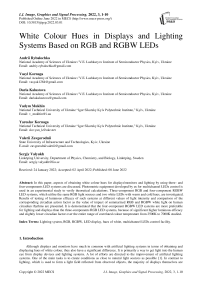White Colour Hues in Displays and Lighting Systems Based on RGB and RGBW LEDs
Автор: Andrii Rybalochka, Vasyl Kornaga, Daria Kalustova, Vadym Mukhin, Yaroslav Kornaga, Valerii Zavgorodnii, Sergiy Valyukh
Журнал: International Journal of Image, Graphics and Signal Processing @ijigsp
Статья в выпуске: 3 vol.14, 2022 года.
Бесплатный доступ
In this paper, aspects of obtaining white colour hues for displays/monitors and lighting by using three- and four-components LED systems are discussed. Photometric equipment developed by us for multichannel LEDs control is used in an experimental study to verify theoretical calculations. Three-component RGB and four-component RGBW LED systems, which utilise the same RGB light sources and two white LEDs with warm and cold hues, are investigated. Results of testing of luminous efficacy of such systems at different values of light intensity and comparison of the corresponding circadian action factor as the value of impact of summarized RGB and RGBW white light on human circadian rhythms are presented. It is demonstrated that the four-component RGBW LED systems are more preferable for lighting and displays than the three-components RGB LED systems, because of significant higher luminous efficacy and slightly lower circadian factor over the entire range of correlated colour temperature from 2500K to 7000K studied.
Lighting system, RGB, RGBW, LED display, hues of white, multichannel LEDs control facility
Короткий адрес: https://sciup.org/15018421
IDR: 15018421 | DOI: 10.5815/ijigsp.2022.03.01
Список литературы White Colour Hues in Displays and Lighting Systems Based on RGB and RGBW LEDs
- E. F. Schubert, “Light-Emitting Diodes,” 2nd ed., Cambridge University Press, 2008.
- G. Сrawford, “Flexible Flat Panel Displays,” United Kingdom, John Wiley & Sons, Ltd, 2005.
- S.-T. Wu and D.-K. Yang, “Fundamentals of Liquid Crystal Devices,” 2nd ed., United Kingdom, Wiley, 2015.
- T. Tsujimura, “OLED Display Fundamentals and Applications,” United Kingdom, Wiley, 2017.
- S.-T. Wu, D.-K. Yang, “Reflective Liquid Crystal Displays,” USA, John Wiley & Sons, Ltd, 2001.
- X.-Y. Huang, D.-K. Yang and J.W. Doane, “Transient dielectric study of bistable reflective cholesteric displays and design of repid drive scheme,” Applied Physics Letters, vol.67, no.9, pp. 1211-1213, 1995.
- A. Rybalochka, V. Sorokin and S. Valyukh, “Bistable cholesteric reflective displays: two-level dynamic drive schemes,” The Journal of the Society for Information Display, vol.12, no.2, pp.165-171,2004.
- V. I. Kornaga, V.M. Sorokin, A.V. Rybalochka, O.S. Oliinyk and N.P. Kornaga, “Color mixing models for smart lighting systems based on RGBW and WW LEDs,” Semiconductor Physics, Quantum Electronics and Optoelectronics, vol. 18, no. 3, pp. 302 – 308, 2015.
- CIE Technical Committee 1-85 of Division 1, “Colour and Vision”, “Method of measuring and specifying colour rendering properties of light sources,” CIE Publication, Vienna, CIE 013.3-1995, 1995.
- EN 12464-1:2021 Light and lighting - Lighting of work places - Part 1: Indoor work places .
- Resolution of the Cabinet of Ministers of Ukraine №992 of 15.10.2012 “Requirements for LED lighting devices and electric lamps used in AC networks with the purpose lighting”.
- P.K. Maiti and B. Roy, “Development of dynamic light controller for variable CCT white LED light source,” LEUKOS, vol. 11, pp. 209 – 222, 2015.
- D. Kalustova, V. Kornaga, A. Rybalochka, V. Mukhin, Y. Kornaga and S. Valyukh, “Red, green, blue, and white clusters for daylight reproduction,” Optical Engineering, vol. 59, no. 5, pp. 1-14, 2020.
- F. Zhang, H. Xu and Z. Wang, “Optimizing spectral compositions of multichannel LED light sources by IES color fidelity index and luminous efficacy of radiation,” Applied Optics, vol. 56, no.7, pp. 1962-1971, 2017.
- M. Royer, “Evaluating tradeoffs between energy efficiency and color rendition,” OSA Continuum, vol. 2, no. 8, pp. 2308-2327, 2019.
- D.M. Berson, F.A. Dunn and M. Takao, “Phototransduction by retinal ganglion cells that set the circadian clock,” Science, vol. 295, pp. 1070-1073, 2002.
- G.C. Brainard, J.P. Hanifin, J.M. Greeson, B.Byrne, G.Glickman, E. Gerner and M.D. Rollag, “Action spectrum for melatonin regulation in humans: evidence for a novel circadian photoreceptor,” The Journal of Neuroscience, vol.21, no.16, pp. 6405-6412, 2001.
- C. Czeisler, J. Duffy, T. Shanahan, E. Brown, J.F. Mitchell, D.W. Rimmer, J. Ronda, E.J. Silva, J.S. Allan, J. Emens, D. Dijk and R. Kronauer, “Stability, precision, and near 24-hour period of the human circadian pacemaker,” Science, vol. 284, pp. 2177 – 2181, 1999.
- G.C. Brainard, D.Sliney, J.P. Hanifin, G. Glickman, B. Byrne, J.M. Greeson, S.Jasser, E.Gerner and M.D. Rollag, “Sensitivity of the human circadian system to short-wavelength (420-nm) light,” Journal of Biological Rhythms, vol. 23, pp. 379-386, 2008.
- D. Gall and K. Beiske, “Definition and measurement of circadian radiometric quantities,” in CIE Symposium 2004 "Light and Health: non-visual effects" (Austria, Viena), 2004, pp. 129-132.
- D. Kalustova, V. Kornaga, O. Oliinyk and A. Rybalochka, “LEDs group control system for research of color mixing methods,” KPI Science News, vol. 3-2020, pp. 24-31, 2020.
- IEC 61966-2-1, Multimedia systems and equipment - Colour measurement and management - Part 2.1: Colour management in multimedia systems - Default RGB colour space – sRGB.
- “Adobe RGB (1998) color image encoding,” (Adobe Systems Inc., San Jose, CA, USA, 2005).
- M.S. Rea, M.G. Figueiro, A. Bierman and R. Hamner, “Modelling the spectral sensitivity of the human circadian system,” Lighting Research & Technology, vol. 44, pp. 386-396, 2011.


